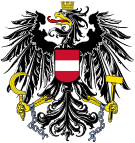| |||||||||||||||||||||||||||||||||||||||||
All 183 seats in the National Council 92 seats needed for a majority | |||||||||||||||||||||||||||||||||||||||||
|---|---|---|---|---|---|---|---|---|---|---|---|---|---|---|---|---|---|---|---|---|---|---|---|---|---|---|---|---|---|---|---|---|---|---|---|---|---|---|---|---|---|
| |||||||||||||||||||||||||||||||||||||||||
 Results of the election, showing seats won by state and nationwide. States are shaded according to the first-place party. | |||||||||||||||||||||||||||||||||||||||||
| |||||||||||||||||||||||||||||||||||||||||
| This article is part of a series on the |
| Politics of Austria |
|---|
 |
Parliamentary elections were held in Austria on 24 April 1983.[1][2][3] The result was a victory for the Socialist Party, which won 90 of the 183 seats. However, the Socialists lost the outright majority they had held since 1971, prompting Bruno Kreisky to stand down as SPÖ leader and Chancellor in favour of Fred Sinowatz. The SPÖ stayed in office by entering into a coalition government with the Freedom Party of Austria, which at this point was a liberal party. Voter turnout was 93%.[4][5]
- ^ Dieter Nohlen & Philip Stöver (2010) Elections in Europe: A data handbook, p196 ISBN 978-3-8329-5609-7
- ^ Sully, Melanie A. (1984). "The 1983 Austrian election". West European Politics. 7 (1): 119–123. doi:10.1080/01402388408424462. ISSN 0140-2382.
- ^ Pulzer, Peter (1983). "The Austrian general election of 1983". Electoral Studies. 2 (3): 275–280. doi:10.1016/S0261-3794(83)80035-3. ISSN 0261-3794.
- ^ Fred Sinowatz: Reluctant chancellor of Austria The Independent, 7 September 2008
- ^ Nohlen & Stöver, p215




